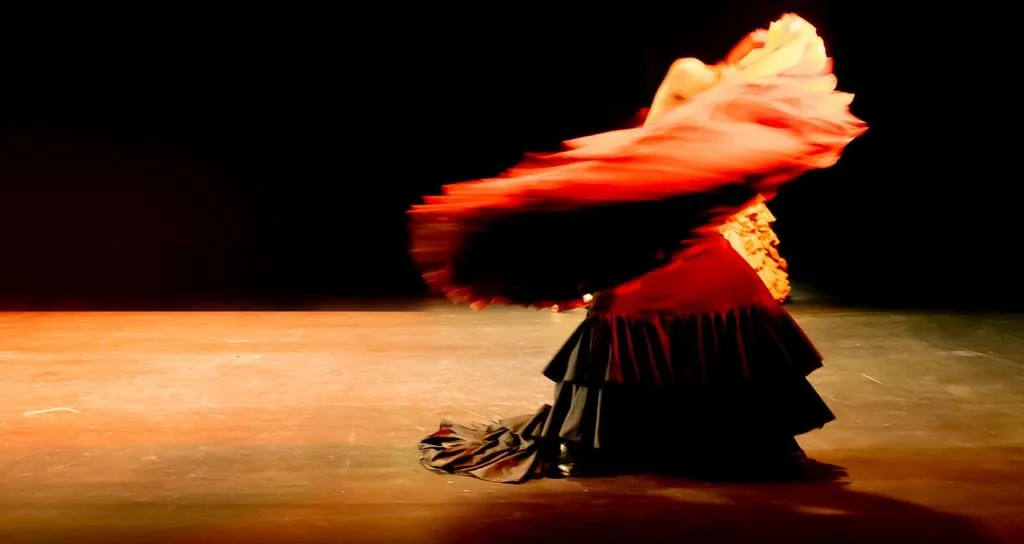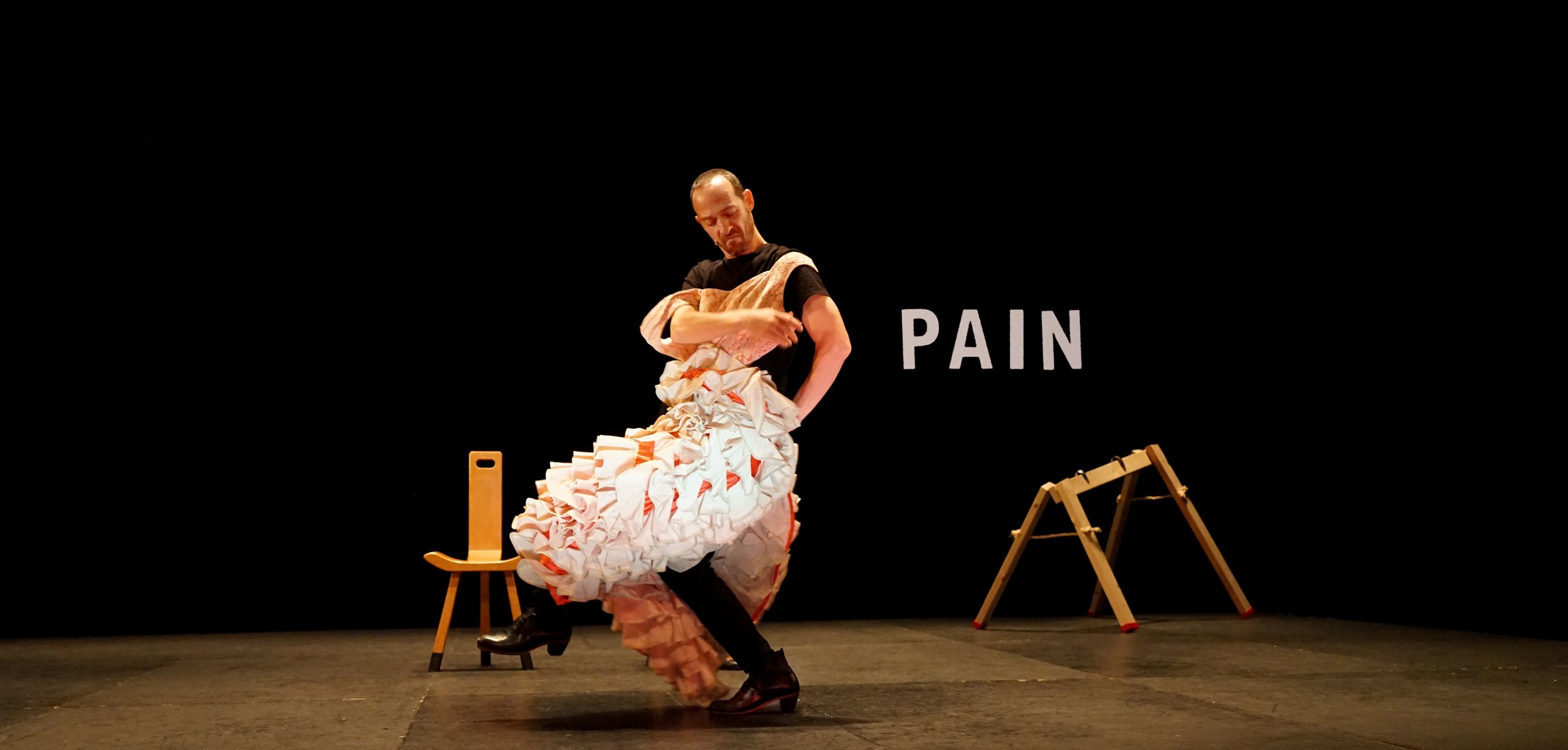
“Almost everyone now talks in dance, but no one does it like Hillel Kogan.
In most premieres this year at ״Curtain Up Festival״, there is an incessant surge of speech. What causes this right now in Israel? One piece, THISISPAIN by Hillel Kogan, answered this question.

Photo: Laetitia Boulud

Photo: Laetitia Boulud

Photo: Eli Katz

Photo: Laetitia Boulud

Photo: Laetitia Boulud

Photo: Laetitia Boulud

Photo: Laetitia Boulud

Photo: Laetitia Boulud

Photo: Laetitia Boulud
Choreography opens like a fan / on Hillel Kogan's – THISISPAIN
By Idit Suslik, PhD, Dance Lecturer, Scholar, and Writer
-
These poles are largely defined even before the work begins in the text that appears in the program, and contains a sequence of descriptive words - some refer to cultural symbols from the past and present (Picasso, Goya, the House of Paper, Almodovar) and historical events (Franco, Columbus, the Inquisition, the Golden Age), while others are more general and represent common perceptions about the Spanish being (sun, wine). Flamenco, on the other hand, does not appear in the text explicitly, despite being one of the distinct symbols of Spanish culture, but it is present in it through the attributes identified with its clichéd image - fans, castanets, black and red and white dots - which took root throughout history at two specific points in time: The European fascination with the Spanish 'other' in the 19th century, which was expressed in the various arts (such as the illustrations of Gustave Doré or the novella Carmen by Prosper Mérimée, and the opera by George Bizet that followed); and Franco's dictatorship (1939-1975), during which the cultural diversity of the distinct provinces of Spain was erased in favor of one artificial identity, whose exaggerated 'Spanish-ness' characteristics were intended to hide the injustices of the government and attract tourists.
The art is revealed when Hillel Kogan enters the stage with flamenco dancer Michal Natan: he sits on a chair and watches her perform complex sequences of steps. At first it seems that this is an authentic cultural expression that balances the collection of signifiers that have been emptied of their meaning in the program, but the performative action is more complex since the footwork has already been established as the purpose of the entire flamenco art, while its function depends and is fulfilled only in relation to the singing - the source of flamenco - and it is introduced into the stage space only when Kogan begins to perform a Martinete, an ancient traditional song-form. From this moment on, it seems that his body - on its many avenues of expression - becomes the scene of an ideological and choreographic struggle between the two 'faces' of Spain and flamenco: He bursts into a monologue full of slogans ("Spain is passion", "a place of exclamation marks", "men are macho, not like us"), after which begins a movement section that opens with the distinct arm work of flamenco, but which gradually moves away from the familiar aesthetics and in a certain moment Kogan even choreographically quotes Israel Galvan - one of the most prominent dancers of the avant-garde movement in flamenco - who in his work Arena from 2004 'quoted' the setting of Vaslav Nijinsky's iconic profile in The Afternoon of a Faun (1912), in order to challenge the showmanship that took root in flamenco upon its release from the family framework and turning it into stage art. At the end, Kogan returns to a defining image related to the Christian identity of Spain, leaning himself against the wall like Jesus crucified.
And this alterity is a dramaturgical key in the work, and is expressed in the way Kogan and Natan break down the elements of flamenco while presenting them: they sit side by side and practice the clapping, which in the 'live' flamenco event is used to 'hold' the rhythmic pattern (compás) of forms - The different songs, thus enabling the existence of musical communication between singing, playing and dancing, which is the essence of art. But at the same time as Natan's counting the rythem, which demonstrate the distribution of accents over a sentence of 12 beats - in contrast to western musical patterns - Kogan points out that "not everything in life has to be 10", gives examples of the importance of the number 12 (the twelve tribes, the time of the pumpkin turning into a carriage, the size of an egg mold, etc.), and even performs a flamenco-style interpretation of Hebrew songs such as "In the Land I Loved". In another section, he brings to a climax the singing of the 'Siguiriya' while performing intense footwork using shoes attached to dance sticks he holds in his hands, an almost cubist occurrence in its aesthetics, due to the dismantling of the body's means of expression in flamenco and their reassembly in a different way than the convention.
Such a foreignness is also frequently applied to the iconography of flamenco: Hillel Kogan and Michal Natan create a disturbed image of a dancer with a long trail of a tail dress (Bata de cola) by walking slowly, back to the audience, between their legs a broom moving slowly from side to side (a moment that is hard not to think as an internal 'wink' into the flamenco field, which responds to the qualities of the dress as an effective cleaning agent for any studio floor or stage). Later, the broom becomes an image of a guitar that Kogan embraces between his arms, or a mantilla - the traditional black lace headdress attached to a comb (peineta) - when Kogan places it above his head, thus he crosses the closed gender coding of flamenco that links attributes of the dance, and even forms - certain songs, with women or men. In this way Kogan places the emerging images - despite their disintegration - on a continuum of artistic and cultural contexts, such as the women as 'majas' in Francisco Goya's paintings, or Bull's Head (1942), a ready-made object created by Pablo Picasso from a bicycle seat and handlebar, which is given a contemporary extension by Kogan and Nathan who attach to the 'head' a straw basket and also a pile of tail dresses which give the 'ox' its body.
But the appeal to the language of flamenco is not limited to an aesthetic layer but overflows the complexity embodied in it in relation to issues of identity and/or cultural ownership of the art. At a certain moment, Hillel Kogan tells the story of Michal Natan's encounter with flamenco, and through it he outlines the dynamics of belonging ("They always thought I was Spanish until I opened my mouth") versus foreignness ("The gypsies I worked with in Spain immediately recognized that I was not a gypsy") that accompanies all flamenco practitioners who are not Spanish and/or gypsies in identity. In another segment, Kogan conducts an imaginary phone conversation with the Spanish embassy in an attempt to obtain citizenship and Nathan encourages him to clarify that he is not a bailarín (dancer) but a bailaor (flamenco dancer), thus confirming the terminological diagnosis that is still prevalent in flamenco and revealing the 'looks' that decipher the field, which preserve a hierarchy between different levels of authentic 'flamenco'. This discourse of identities also progresses beyond flamenco and Spain, when Kogan sails through the analysis of geopolitical relations between other countries, but its deep meaning is revealed when the issue comes to the personal: "I am not Spanish, my grandmother did not sing me lullabies in flamenco, I will remain the gay Tel Avivian Hillel Kogan." Precisely there, in this deterministic statement, Kogan reveals the universal power of flamenco, as an art that 'speaks' pain - the most human language that dissolves any cultural definition - that "connects you to your own pain". Accordingly, he concludes his work with what appears to be a choreographic quotation of one of the iconic moments of pain in Spanish cinema and dance: the slow collapse of the body to the floor in the film Blood Wedding (1981) by Carlos Saura and Antonio Gades, as an intensification of the criticism expressed by the poet Federico García Lorca in his 1933 play against glorification of death in Spanish culture.
In many ways, THISISPAIN takes place in an aesthetic and intellectual threshold space: it seems that Hillel Kogan built it as a flamenco show - it moves between the main song-forms of the genre and thus provides a layout of the emotional range inherent in it, and its organizing action is the dialogue between Kogan and Michal Natan, which sharpens the essence of flamenco as communication between people through music, voice and movement. At the same time, it is evident that the treatment of flamenco is guided by contemporary dance practices that reflect Kogan's reflexive position, and turn the entire work into what can be defined as 'meta-choreography', i.e. - a deliberate and conscious use of flamenco, to reveal the mechanisms of its activation and representation as art, language, technique, institutions and history. However, in THISISPAIN Hillel Kogan does not confront flamenco only as someone who researches it from the outside but also as someone who has experienced it from the inside in the last year. This change is reflected in his position within the work, which is different from before: if in We Love Arabs, The Swan and the Pimp, and What Now, Kogan is present in a declared way as a choreographer (opposite a dancer who represents the Arab 'other', a young dancer, and a colleague-partner in the choreographic act), this time he is also a student, which colors the ironic and exploratory observation in shades of true and not patronizing fascination, joy of discovery and uncertainty of knowledge, and above all - respect for heritage and art that brings man together with himself, in the most exposed way.
Idit Suslik, PhD, Dance Lecturer, Scholar, and Writer
Choreography: Hillel Kogan
Performed by Mijal Natan and Hillel Kogan
Lights Design: Nadav Barnea
Art Direction: Laetitia Boulud
Dramaturge: Yael Venezia
Music Advisor: Yael Horwitz
Premiered at the 2022 Curtain Up Festival, Israel
SELECTED REVIEWS
15.11.2022 - Ran Brown, Ha’aretz (he) (en)
21.11.2022 - Ora Brafman, The Jerusalem post (en)
26.11.2022 - Idit Suslik, The Contemporary Eye (he) (en)
29.05.2023 - Anat Zecharia, Hamevakeret (he)
08.07.23 - Mathias Daval, La Gazette Des Festivals (fr)
19.07.23 - Louise Chevillard, La Terrass (fr)
21.07.23 - Loeil dolivier, Chroniques Culturelles et Rencontres Artistiques (fr)
21.07.23 - Genevieve charras, L'amuse-danse ! (fr)
22.07.23 - Véronique Giraud, Naja21 (fr)
25.07.23 - Jean Louis Rossi et Alain Blum, Licra (fr)
20.07.2023 - Louise Chevillard, journal-laterrasse (fr)
